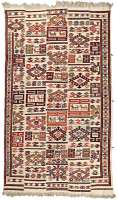|
|
TODAY.AZ / Arts & Entertainment
Carpet Museum displays Shirvan zili carpet
12 April 2021 [10:17] - TODAY.AZ

By Azernews
By Laman Ismayilova
Azerbaijan National Carpet Museum has showcased Shirvan zili carpet. The carpet is currently on display at the Russian Museum of Ethnography as part of the joint exhibition.
The exposition "Weaving the thread of fate into the carpet. Decorative and applied art of Azerbaijan in the collection of the Russian Ethnographic Museum" features over 100 unique samples of decorative and applied art.
The exposition displays around 40 carpets and carpet products as well as other works of decorative and applied art by Azerbaijani artists of the 19th–20th centuries.
Most of the carpets were made in the second half of the 19th – the first decade of the 20th century.
The late-18th-century Surakhani carpet is the oldest and most unique piece of the exhibition.
Shirvan zili carpet is adorned with elements of various meanings, characteristic of Shirvan carpets.? Old carpet weavers called these stylized ornaments givrim (curl), ajdaha (dragon), kilim-gulu (kilim flower), as well as gosha buynuz (double horn) decorated with darag (comb) and tazi (dog) elements.? The carpet`s border feature kechi (goat) elements against a white background, symbolizing the lunar cult.
The Carpet Museum also provided insight into Lamp carpets of Karabakh carper school, designed on the bas of the Lechek-Turunj composition.
Since the first half of the 19th century, these had been woven in Shusha and in all carpet weaving centers of Karabakh.
These carpets decorated the walls and ceiling of big houses. As a rule, Lampe carpets were woven as a set, including two side carpets and one central.
The big eight-pointed medallion in the center is typical for Lampe carpets. The elongated ketebes? adorn the top and bottom parts of the medallion. Parrot images decorate? the? empty spaces of the central field near the medallion. The artistic design of the central field is enriched with big lachaks (petals) in the corners of the carpet.
Notably, Karabakh carpets are distinguished from other national carpet schools by their artistic and technological production and their size.
This carpet school is famous for its pileless carpets, including shadda, zili, verni, kilim and palas products. Karabakh carpets are characterized by bright colors and vegetative motives.
There are 33 compositions of Karabakh carpets. These carpets are produced in the towns Malibeyli, Muradkhanli, Dashbulag, Jabrayil, Horadiz in Karabakh in mountainous part of Karabakh.
In the 19th century, Shusha city and Dashbulag, Dovshanli, Girov, Trinivz, Chanakhchi, Tug, Kohna Tughlar, Hadrut, Muradkhanli, Gasimushagi, Gubadli, Gozag, Mirseyid, Bagirbeyli, Khanlig, Dag Tumas and other villages of mountanious zone of Karabakh had essential role in the carpet weaving production.
With its colorful patterns and manufacturing technique., Zangazur and Nakhchivan are also included in Karabakh carpet school.
These carpet compositions feature classical patterns of Karabakh carpet-weaving school, including "Aran”, "Bagchadaguller", "Bal?g", "Buynuz", "Barda", "Bahmanli", "Garabag", "Goja", "Gasimushagi", "Lambaran", "Mugan", "Talish", "Lampa", "Malibayli ", "Khangarvand", "Khanlig", "Khantirma", "Chalabi", and "Shabalidbuta".
With its rich colors, this carpet school comprises all undertones of nature of Karabakh. Besides various plants, these colors are gained from different kinds of insects. The most popular insect from which red color is produced is scale insect or red worm.



URL: http://www.today.az/news/entertainment/204958.html
 Print version
Print version
Connect with us. Get latest news and updates.
See Also
- 22 October 2025 [15:35]
Renowned children’s author joins literary meeting - 22 October 2025 [14:56]
Reza Deghati visits Baku to mark 5th anniversary of Victory Day - 22 October 2025 [14:20]
Kazakh musicians dazzle with stunning performance - 22 October 2025 [12:57]
'Wind of Culture' project launched in Garabagh region - 22 October 2025 [12:17]
Master classes dedicated to Uzeyir Hajibayli conclude - 22 October 2025 [10:42]
CINEMO Int'l Mobile Film Festival to be held for third time - 21 October 2025 [15:17]
Young Spectators Theater to stage new production - 21 October 2025 [13:24]
Azerbaijan awards winners Astronomy Olympiad - 21 October 2025 [12:36]
Honored Art Worker Ali Amirli releases new book - 21 October 2025 [12:33]
“Grammar of the Iraqi-Turkmen Language” published for first time
Most Popular
 Alone in field is not warrior: time has come for military component of OTG
Alone in field is not warrior: time has come for military component of OTG
 Azerbaijan and Kazakhstan are taking region's geopolitics into their own hands
Azerbaijan and Kazakhstan are taking region's geopolitics into their own hands
 Azerbaijan’s green energy shift redraws map from Central Asia to Europe
Azerbaijan’s green energy shift redraws map from Central Asia to Europe
 Feasibility study for Central Asia–Azerbaijan Green Energy Corridor to begin in November
Feasibility study for Central Asia–Azerbaijan Green Energy Corridor to begin in November
 Paraguay seeks greater influence in divided MERCOSUR as trade with the EU gains traction
Paraguay seeks greater influence in divided MERCOSUR as trade with the EU gains traction
 Azerbaijan to begin satellite manufacturing, launches new space industry milestone
Azerbaijan to begin satellite manufacturing, launches new space industry milestone
 Boeing 747 overshoots Hong Kong runway, partially submerges in sea
Boeing 747 overshoots Hong Kong runway, partially submerges in sea
